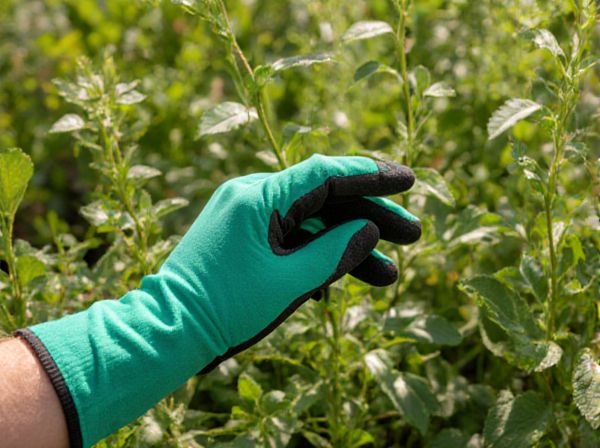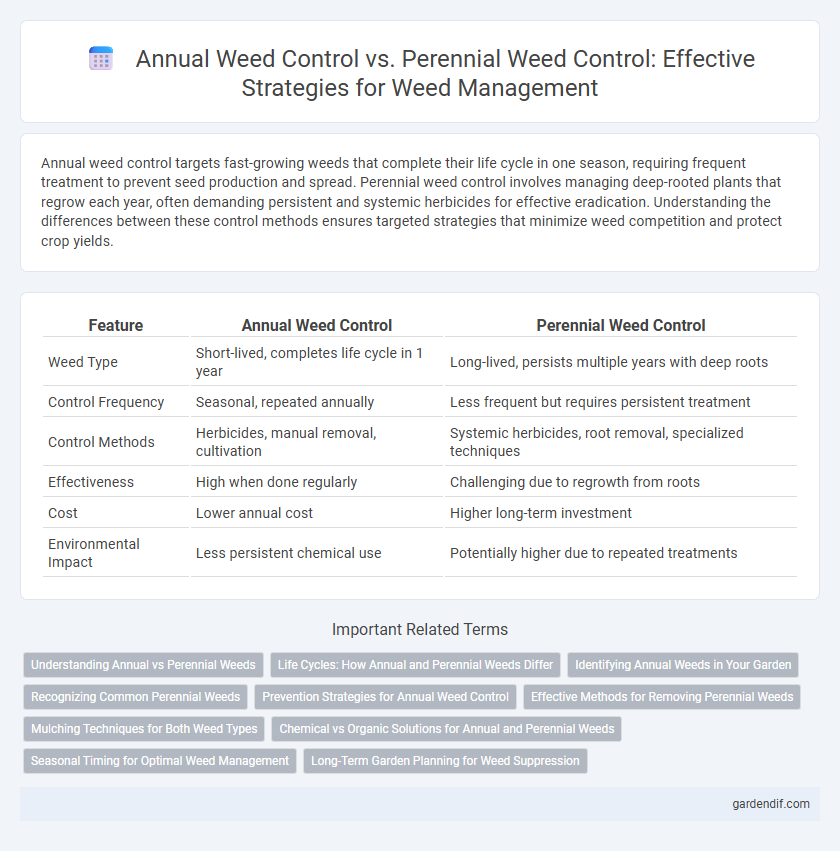
Annual Weed Control vs Perennial Weed Control Illustration
Annual weed control targets fast-growing weeds that complete their life cycle in one season, requiring frequent treatment to prevent seed production and spread. Perennial weed control involves managing deep-rooted plants that regrow each year, often demanding persistent and systemic herbicides for effective eradication. Understanding the differences between these control methods ensures targeted strategies that minimize weed competition and protect crop yields.
Table of Comparison
| Feature | Annual Weed Control | Perennial Weed Control |
|---|---|---|
| Weed Type | Short-lived, completes life cycle in 1 year | Long-lived, persists multiple years with deep roots |
| Control Frequency | Seasonal, repeated annually | Less frequent but requires persistent treatment |
| Control Methods | Herbicides, manual removal, cultivation | Systemic herbicides, root removal, specialized techniques |
| Effectiveness | High when done regularly | Challenging due to regrowth from roots |
| Cost | Lower annual cost | Higher long-term investment |
| Environmental Impact | Less persistent chemical use | Potentially higher due to repeated treatments |
Understanding Annual vs Perennial Weeds
Annual weed control targets weeds that complete their life cycle within one growing season, requiring treatments focused on seed prevention and rapid removal. Perennial weed control addresses weeds that regrow from roots or rhizomes over multiple years, demanding persistent and systemic treatment methods to eradicate underground parts. Effective weed management depends on correctly identifying annual versus perennial species to apply appropriate herbicides and cultural controls.
Life Cycles: How Annual and Perennial Weeds Differ
Annual weeds complete their life cycle within one growing season, sprouting from seeds, maturing, and dying off within months, which makes control strategies focused on seed prevention and rapid eradication. Perennial weeds survive for multiple years through robust root systems or underground structures like rhizomes and tubers, requiring more persistent control methods targeting both above-ground growth and extensive root networks. Understanding these distinct life cycles is crucial for effective weed management, as annual weeds primarily propagate through seeds while perennials regenerate vegetatively, demanding tailored approaches for lasting suppression.
Identifying Annual Weeds in Your Garden
Annual weeds complete their life cycle in one growing season, making prompt identification and removal crucial to prevent seed dispersal and reinfestation. Common annual weeds include crabgrass, purslane, and chickweed, which thrive in disturbed soil and can quickly overrun garden beds if left unmanaged. Effective control involves regular monitoring during the growing season and timely application of pre-emergent herbicides to disrupt germination cycles.
Recognizing Common Perennial Weeds
Common perennial weeds such as bindweed, dandelion, and quackgrass require targeted control methods that differ from those used for annual weeds, which complete their life cycle in one growing season. Recognizing these perennial species by their deep root systems and persistent regrowth helps in selecting effective treatments like systemic herbicides that penetrate roots for long-term control. Proper identification of perennial weeds ensures sustainable management strategies, reducing the likelihood of repeated infestations and minimizing turf or crop damage.
Prevention Strategies for Annual Weed Control
Effective prevention strategies for annual weed control emphasize timely soil preparation and the use of pre-emergent herbicides to inhibit seed germination. Maintaining healthy, dense turfgrass or crop covers reduces available space and resources for annual weeds to establish. Implementing crop rotation and mulching further disrupts weed life cycles and minimizes soil seed banks, enhancing long-term annual weed management.
Effective Methods for Removing Perennial Weeds
Effective methods for removing perennial weeds include targeted herbicide applications, mechanical removal, and soil solarization. Utilizing systemic herbicides such as glyphosate ensures deep root destruction, while repeated cultivation weakens root systems over time. Integrating mulch and landscape fabric also inhibits regrowth by blocking sunlight essential for perennial weed development.
Mulching Techniques for Both Weed Types
Mulching techniques effectively suppress both annual and perennial weeds by blocking sunlight and reducing seed germination. Organic mulches such as wood chips and straw decompose over time, enriching soil while controlling annual weed growth, whereas heavier mulches or landscape fabrics provide a physical barrier essential for disrupting perennial weed root systems. Selecting the appropriate mulch type based on weed root structure optimizes long-term weed management and soil health.
Chemical vs Organic Solutions for Annual and Perennial Weeds
Chemical solutions for annual weed control often involve fast-acting herbicides like glyphosate or 2,4-D, targeting seedling growth and preventing weed establishment. Organic methods rely on manual removal, mulching, or natural compounds such as vinegar-based herbicides, emphasizing soil health and minimizing environmental impact. For perennial weeds, chemical treatments usually require systemic herbicides to eradicate deep-rooted plants, while organic approaches focus on repeated physical disruption and strengthening native vegetation to outcompete persistent weeds.
Seasonal Timing for Optimal Weed Management
Annual weed control requires targeting specific growth stages during the spring and early summer to prevent seed production and spread. Perennial weed management is most effective when applied in late summer or early fall, as plants translocate nutrients to roots, enhancing herbicide uptake. Timing applications to these seasonal growth phases maximizes control efficacy and reduces long-term weed pressure.
Long-Term Garden Planning for Weed Suppression
Annual weed control targets fast-growing weeds that emerge each season, requiring frequent interventions to prevent seed spread and soil infestation. Perennial weed control focuses on deep-rooted plants with persistent root systems, demanding strategic, long-term methods such as root-targeted herbicides and soil solarization. Integrating both approaches enhances sustainable garden health, reduces chemical usage, and supports effective long-term weed suppression.
Annual Weed Control vs Perennial Weed Control Infographic

 gardendif.com
gardendif.com